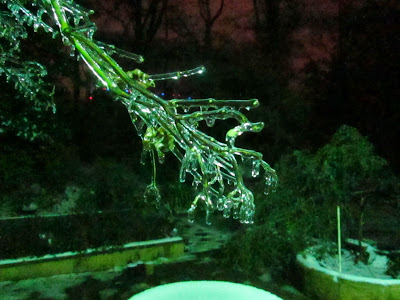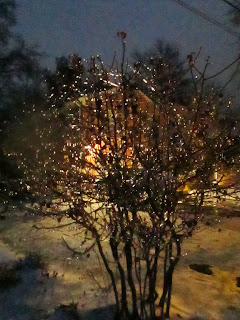UPDATE 10:12 PM 12/9/13
Hi-res NAM radar simulation for 7:00 AM Total liquid-equivalent precip shows heavy snow
UPDATE 9:05 PM 12/9/13
The NWS has upgraded a narrow band spanning across DC into a Winter Storm Warning for 3-6 inches of snow.
...WINTER STORM WARNING IN EFFECT FROM 3 AM TO 2 PM EST TUESDAY...
THE NATIONAL WEATHER SERVICE IN BALTIMORE MD/WASHINGTON HAS
ISSUED A WINTER STORM WARNING FOR SNOW...WHICH IS IN EFFECT FROM
3 AM TO 2 PM EST TUESDAY. THE WINTER WEATHER ADVISORY IS NO LONGER
IN EFFECT.
* PRECIPITATION TYPE...SNOW...HEAVY AT TIMES. PRECIPITATION MAY
START AS A PERIOD OF SNOW AND SLEET BEFORE DAWN CHANGING TO ALL
SNOW AFTER DAYBREAK.
* ACCUMULATIONS...3 TO 6 INCHES.
* TIMING...AROUND DAYBREAK TUESDAY LASTING THROUGH EARLY TUESDAY
AFTERNOON...INCLUDING THE TUESDAY MORNING RUSH HOUR.
* TEMPERATURES...UPPER 20S TO LOWER 30S.
* WINDS...NORTHWEST 5 TO 10 MPH.
* IMPACTS...HAZARDOUS TRAVEL CONDITIONS ARE EXPECTED FROM HEAVY
SNOW. THE SNOW WILL IMPACT THE MORNING RUSH TUESDAY WITH THE
POTENTIAL FOR ACCUMULATION RATES OF 1-2 INCHES PER HOUR.
Original Text
Once again, more winter weather is projected to impact the DC metro and once again, there is a lull just before it. Tonight, temps will drop back below freezing so refreezing may occur. In addition, a Dense Fog Advisory is in effect until 3AM. If you plan to be out and about, use caution.
...DENSE FOG ADVISORY NOW IN EFFECT UNTIL 3 AM EST TUESDAY...
* VISIBILITIES...ONE-QUARTER MILE OR LESS.
* IMPACTS...AREAS OF DENSE FOG WILL CAUSE SUDDEN REDUCTIONS IN
VISIBILITY AND RAPIDLY CHANGING CONDITIONS. BLACK ICE WILL ALSO
FORM WHEN TEMPERATURES DROP TO BELOW FREEZING THIS EVENING...
ESPECIALLY ON UNTREATED ROADS...BRIDGES AND OVERPASSES.
The NWS has a issued a Winter Weather Advisory for the entire DC area starting 3 AM and lasting till 2PM for a quick hitting 3-5 inches of snow. The snow may start off with some sleet mixed in.

...WINTER WEATHER ADVISORY IN EFFECT FROM 3 AM TO 2 PM EST
TUESDAY...
THE NATIONAL WEATHER SERVICE IN BALTIMORE MD/WASHINGTON HAS
ISSUED A WINTER WEATHER ADVISORY FOR SNOW... WHICH IS IN EFFECT
FROM 3 AM TO 2 PM EST TUESDAY. THE WINTER STORM WATCH IS NO
LONGER IN EFFECT.
* PRECIPITATION TYPE...SNOW...HEAVY AT TIMES. THE PRECIPITATION
MAY START AS A PERIOD OF SLEET...ESPECIALLY SOUTH OF INTERSTATE
66 IN VIRGINIA AND EAST OF INTERSTATE 95.
* ACCUMULATIONS...3 TO 5 INCHES.
* TIMING...NEAR DAWN TUESDAY THROUGH EARLY TUESDAY AFTERNOON...
INCLUDING THE TUESDAY MORNING RUSH HOUR.
* TEMPERATURES...UPPER 20S TO LOWER 30S.
* WINDS...NORTHWEST 5 TO 10 MPH.
* IMPACTS...HAZARDOUS TRAVEL CONDITIONS ARE EXPECTED FROM HEAVY
SNOW. THE SNOW WILL IMPACT THE MORNING RUSH TUESDAY WITH THE
POTENTIAL FOR ACCUMULATION RATES OF 1-2 INCHES PER HOUR.
PRECAUTIONARY/PREPAREDNESS ACTIONS...
A WINTER WEATHER ADVISORY MEANS THAT PERIODS OF SNOW WILL CAUSE
TRAVEL DIFFICULTIES. BE PREPARED FOR SLIPPERY ROADS AND LIMITED
VISIBILITIES...AND USE CAUTION WHILE DRIVING.
Precip will enter the area in the early morning hours and overspread the area by 6. The storm will be quick moving, but badly timed, with the heaviest snow coming in as students prepare to go to school. Temps will drop as the precip moves in. Bands of heavy snow may develop just in time for rush hour. There is a possibility of preemptive school closures due to the possible heavy snow. Temperatures in the upper levels will be very cold, possibly contributing to higher liquid to snow ratios which means higher accumulations and fluffier and drier snow.
Beyond tomorrow, skies will clear but temps will plummet. Forecast highs will struggle to reach freezing and lows will be in the teens to single digits until Friday. The coldest day will be Wednesday, with forecast highs in the 20s and lows on Weds night in the single digits. Bundle up everybody!
How to measure Snow: http://www.srh.noaa.gov/productview.php?pil=PNSSEW&max=61
Thanks for reading,
-Alex















































.png)


